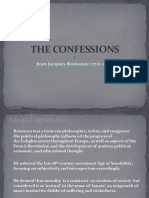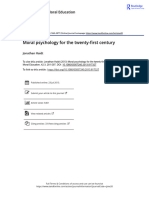VAN FRAASSEN Scientific Representation: Paradoxes of Perspective
VAN FRAASSEN Scientific Representation: Paradoxes of Perspective
Uploaded by
themostatomikratCopyright:
Available Formats
VAN FRAASSEN Scientific Representation: Paradoxes of Perspective
VAN FRAASSEN Scientific Representation: Paradoxes of Perspective
Uploaded by
themostatomikratOriginal Title
Copyright
Available Formats
Share this document
Did you find this document useful?
Is this content inappropriate?
Copyright:
Available Formats
VAN FRAASSEN Scientific Representation: Paradoxes of Perspective
VAN FRAASSEN Scientific Representation: Paradoxes of Perspective
Uploaded by
themostatomikratCopyright:
Available Formats
BOOK SYMPOSIUM
Scientific Representation: Paradoxes of Perspective
By BAS C. VAN FRAASSEN Oxford University Press, 2008. 416 pp. 35.00 cloth, 18.99 paper Summary
Downloaded from http://analysis.oxfordjournals.org/ by guest on November 26, 2013
BAS
VAN
FRAASSEN
The behaviour of pendulums and bouncing springs was well-known by Newtons time, but he represented both as systems subject to a force varying directly with the distance from a mid-point. Today we would say that Newtons theory provides models satisfying F = kx, and these models can be used to represent such phenomena. 1. Representation To understand what is involved in such a view of science we must first of all focus on representation. To represent is certainly not simply to produce scale copies, whether physical or abstract, though scientific representations do typically trade on selective resemblances in certain respects for their success. Just as artistic representations do, they trade also on selective distortion and systematic non-resemblance in other respects, and often embed the represented phenomena in much larger structures involving non-phenomenal elements. The pertinent selectivity needs to be conveyed, somehow, if the artefact, the vehicle of representation, is to represent its target. Think of a specific use of a graph of an exponential function. Does it represent the growth of a bacteria colony, of a bank account with compound interest or of the result of radioactive decay? Nothing that is in the graph or its structural relations to those three possible targets answers that question. If the selection is indicated by signs placed in the artefact itself, that task of identification is only pushed back a step. Thus, what determines the representation relationship must be a relation of what is in the artefact to factors neither in the artefact itself nor in what is being represented. The conclusion advanced is that there is no representation except in the sense that some things are used, made or taken, to represent some things as thus or so. This conclusion places use and user, and
Analysis Reviews Vol 70 | Number 3 | July 2010 | pp. 511514 doi:10.1093/analys/anq042 The Author 2010. Published by Oxford University Press on behalf of The Analysis Trust. All rights reserved. For Permissions, please email: journals.permissions@oxfordjournals.org
512 | book symposium
the role of indexical judgement, centre-stage in the analysis of scientific representation.
2. The Problem of Coordination Measurements occur in experimental procedure, under artificially designed conditions for empirical investigation. Under these conditions, measurement procedures produce representations images with complex, theorymediated relations to the entities on which the measurements are made. The content of the measurement outcome that is, the appearance of the measured object in the measurement set-up locates that object in a theoryprovided logical space. Clock readings and star sightings at sea may place the ship in the geographic space of latitudes and longitudes, measurements of acceleration in an Atwood machine may locate the two bobs in a mass-ratio relationship, a thermometer reading may locate the body on the Celsius scale. It is through measurement that the theoretical quantities in a model, or in the logical space whose points are a family of theoretical models, are coordinated to the physical world. The term coordination appeared in Machs writings on measurement in thermodynamics and became salient for the relation between mathematical and physical geometry in the decades straddling 1900. It came to prominence through the writings of Schlick and Reichenbach when logical empiricism was beginning to break with neoKantianism. The questions What counts as a measurement of (physical quantity) X? and What is (that physical quantity) X? cannot be answered independently of each other the famed hermeneutic circle. I examine this apparent circularity by focusing both on its more abstract consideration by Reichenbach, and on the practical response in history examined by Mach and Poincare , with the conclusion that pure or presuppositionless coordination is neither possible nor required. To examine the problem of coordination, measurement is here explored first of all from within as such procedures evolve in interaction with an evolving theory. Thereafter, measurement is then explored from above: that is, after the measurement procedures, concepts and theories have stabilized. This resting point in the conceptual and scientific development is fleeting and momentary yet marks a context in which it makes sense to ask about the world-picture of currently accepted physical theory. The physical conditions of possibility for measurement, the general theory of measurement and what cannot count as measurement in a theoretical context, are discussed, drawing on general lessons derived from 20th century foundations of physics. There is more to measurement than its physical correlate. A broad concept of measurement must accommodate both the constraints on its physical correlate and its function of information gathering, which requires that the measurement outcome is an event that has meaning. Measurement is itself
Downloaded from http://analysis.oxfordjournals.org/ by guest on November 26, 2013
book symposium | 513
a specific form of self-location, in a logical space; it is thus a practical form of representation presupposing a prior theoretical representation.
3. Structuralism Empiricist views are typically suspected of leading to either scepticism or idealism. Meanwhile, the scientific realism of the 1960s landed in difficulties that made it split into 57 or so varieties since the 1980s. The idea that what is central to scientific representation is structure, introduced by John Worrall in the mid 80s to save scientific realism, was so thoroughly linked to empiricist heroes such as Duhem, Poincare and Carnap that it appealed greatly to both sides. Its core in empiricist eyes was formulated by Hermann Weyl: that science can never determine its subject-matter except up to isomorphic representation. But there were serious difficulties to overcome, first of all that highlighted by Newmans famous argument which demolished Russells (and implicitly Carnaps) structuralism, and had reappeared as the core of Putnams modeltheoretic argument against metaphysical realism. To formulate an empiricist structuralism it is necessary first of all to emphasize that it must be a view on what science is, not a view of nature pertaining to a form-matter distinction. Secondly, this needs to be done in such a way that this view of science, as structural representation, does not lose sight of the aim, the criterion of success, of the scientific enterprise, which is to be adequate to the actual phenomena. The Loss of Reality threat looms large when the relation of structural representation to its real target is at issue, and particularly for an empiricist who cannot have recourse to the metaphysical realist idea of structure in nature postulated to be the mirrored duplicate of structure in a scientific model. Scientific representation typically displays a hierarchical structure in which higher theories have their models instantiated in those of more specific lower theories, all the way down to data models constructed directly from measurement results on actual phenomena. Since it is always only structure that is in play, we can think of all models as mathematical structures. Such relations as isomorphism and homomorphism are well defined precisely, but only, for mathematical entities. But in the end, how is a model even at the lowest level related to the phenomena being modelled? The phenomena are not mathematical entities, yet we present those models as representing them. At this point, focus must shift from the representation in the sense of the thing used to represent to representation in the sense of the act of representing. To offer something X as a representation of Y as F involves making claims about Y, and the adequacy of the representation hinges on the truth of those claims, but that point does not put us in the clutches of a metaphysics
Downloaded from http://analysis.oxfordjournals.org/ by guest on November 26, 2013
514 | book symposium
of truth makers. A good part of the present symposium is devoted to this point.
4. Appearance vs. Reality as a Scientific Problem The appearances, as distinct from the phenomena themselves, are the contents of outcomes of measurements performed on the accessible phenomenal entities. Thus saving the phenomena must be distinguished from saving the appearances. Philosophical appreciation of the sciences has traditionally seen them as having three main levels. There is theorica (to use an old term) where an underlying physical reality is postulated; then the phenomena, that is, the observable objects, events and processes that are to be accounted for; and finally the appearances in which those phenomena are manifest. Traditionally there have also been strong completeness criteria in play, at least as regulative ideals, such as, at one time, the conviction that scientific accounts are not complete till they achieve the form of deterministic theories. The one criterion that has survived longest is that the theory must show how the appearances derive from, are produced by the postulated underlying reality: the Appearance from Reality Criterion. Two examples implicitly violate the criterion: Leibnizs contention that the derivations exist but are beyond human comprehension, and the contention that psychological phenomena supervene on but are irreducible to the physical. More important is the argument from the measurement problem in quantum mechanics to show that the Copenhagen physicists explicitly refused to see that criterion as incumbent on scientific practice. Together these four parts present an empiricist, updated version of the Bildtheorie, the picture theory of science, as aiming to create empirically adequate representations of the empirical phenomena.
Downloaded from http://analysis.oxfordjournals.org/ by guest on November 26, 2013
Empiricist Structuralism, Metaphysical Realism, and the Bridging Problem
GABRIELE CONTESSA
1. Scientific realism (or at least one version of it) can be characterized as the conjunction of three theses, which, following Stathis Psillos (2000), I shall call the metaphysical, the semantic and the epistemological theses. The
Analysis Reviews Vol 70 | Number 3 | July 2010 | pp. 514524 doi:10.1093/analys/anq040 The Author 2010. Published by Oxford University Press on behalf of The Analysis Trust. All rights reserved. For Permissions, please email: journals.permissions@oxfordjournals.org
You might also like
- Callon Struggles and Negotiations 1980Document23 pagesCallon Struggles and Negotiations 1980paulusmil100% (1)
- Bryan Wilson - RationalityDocument293 pagesBryan Wilson - Rationality程 謙No ratings yet
- James Ladyman 1998 What Is Structural Realism?Document16 pagesJames Ladyman 1998 What Is Structural Realism?EricPezoa100% (1)
- (BC) Kopytoff - The Cultural Biography of Things Commoditization As ProcessDocument29 pages(BC) Kopytoff - The Cultural Biography of Things Commoditization As ProcessKostasBaliotisNo ratings yet
- About Catherine ChalierDocument1 pageAbout Catherine ChalierMichael SmithNo ratings yet
- A Surge TankDocument22 pagesA Surge Tankrizki4kbar100% (1)
- Bok:978 1 137 56216 6Document317 pagesBok:978 1 137 56216 6fivalen1_443898619No ratings yet
- Won Choi - Inception or Interpellation? The Slovenian School, Butler, and AlthusserDocument17 pagesWon Choi - Inception or Interpellation? The Slovenian School, Butler, and AlthusserwaltwalNo ratings yet
- Henrik Olesen. InglesDocument226 pagesHenrik Olesen. InglesXavierNo ratings yet
- Chance Between Holism and Reductionism: Tensions in The Conceptualisation of LifeDocument23 pagesChance Between Holism and Reductionism: Tensions in The Conceptualisation of LifeManuel Quezada CNo ratings yet
- Bird A. - Eliminative Abduction. Examples From MedicineDocument8 pagesBird A. - Eliminative Abduction. Examples From MedicineFede FestaNo ratings yet
- The Peircean Symbol and Its ApplicationDocument25 pagesThe Peircean Symbol and Its ApplicationpepegoterayalfmusicNo ratings yet
- The ConfessionsDocument13 pagesThe ConfessionsSakalam DebbramaNo ratings yet
- Binary CodesDocument53 pagesBinary CodesMartin ZamkotsianNo ratings yet
- Why Do We Care About Literary Characters (Blakey Vermeule) (Z-Library)Document291 pagesWhy Do We Care About Literary Characters (Blakey Vermeule) (Z-Library)woejozneyNo ratings yet
- Mary Shepherd PDFDocument56 pagesMary Shepherd PDFMarcela B. Tavares100% (1)
- Sociological Theory and Social Practice - KurtzDocument13 pagesSociological Theory and Social Practice - KurtzAisyah NovanarimaNo ratings yet
- Thomasson - Fictional EntitiesDocument18 pagesThomasson - Fictional EntitiesJuan Pablo FautschNo ratings yet
- Nagel-Logic Without OntologyDocument32 pagesNagel-Logic Without OntologyTrad Anon100% (2)
- Henaff-Anthrop of Gift Exchanges& RecognDocument16 pagesHenaff-Anthrop of Gift Exchanges& RecognCInematiXXXNo ratings yet
- Holbraad. Response To Bruno Latour's Thou Shall Not Freeze-FrameDocument14 pagesHolbraad. Response To Bruno Latour's Thou Shall Not Freeze-FrameLevindo Pereira100% (2)
- Ruse, Michael - Mystery of MysteryDocument320 pagesRuse, Michael - Mystery of Mysteryapi-3703831No ratings yet
- Andy Clark - Being There (1.7) PDFDocument58 pagesAndy Clark - Being There (1.7) PDFAmanda SerafimNo ratings yet
- Mathematical Power of Epicyclical Astronomy (Hanson) PDFDocument10 pagesMathematical Power of Epicyclical Astronomy (Hanson) PDFEnrique SierraNo ratings yet
- Bourdieu Contra OrtnerDocument125 pagesBourdieu Contra Ortnerstavrianakis9801100% (1)
- A-C Taylor - Distinguishing OntologiesDocument4 pagesA-C Taylor - Distinguishing OntologiesLeif GrunewaldNo ratings yet
- Berti, Enrico - Ancient Greek Dialectic As Expression of Freedom of Thought and Speech - JHI, 39, 3 - 1978 - 347-370Document25 pagesBerti, Enrico - Ancient Greek Dialectic As Expression of Freedom of Thought and Speech - JHI, 39, 3 - 1978 - 347-370the gatheringNo ratings yet
- Exploring Randomness PDFDocument2 pagesExploring Randomness PDFLaurenNo ratings yet
- The Skeptic Way Sextus Empiricuss Outlines of Pyrrhonism - NodrmDocument356 pagesThe Skeptic Way Sextus Empiricuss Outlines of Pyrrhonism - Nodrmdgdksj dfjsjsjdNo ratings yet
- Émile Meyerson - Explanation in The Sciences-Springer Netherlands (1991) PDFDocument649 pagesÉmile Meyerson - Explanation in The Sciences-Springer Netherlands (1991) PDFGawanNo ratings yet
- H.L. Dreyfus - Could Anything Be More Intelligible Than Everyday IntelligibilityDocument25 pagesH.L. Dreyfus - Could Anything Be More Intelligible Than Everyday IntelligibilitygiuseppinodifloridaNo ratings yet
- L. Strauss - ''What Do Liberal & Conservative Mean Here & Now'' 1968Document5 pagesL. Strauss - ''What Do Liberal & Conservative Mean Here & Now'' 1968Sir Toby BelchNo ratings yet
- Siuda-Krzywicka (2019) What Cognitive Neurology Teaches Us About Our Experience of ColorDocument14 pagesSiuda-Krzywicka (2019) What Cognitive Neurology Teaches Us About Our Experience of ColorMiniNo ratings yet
- Haidt - 2013 - Moral Psychology For The Twenty-First CenturyDocument18 pagesHaidt - 2013 - Moral Psychology For The Twenty-First CenturykenlightNo ratings yet
- MAN - Catholic EncyclopediaDocument6 pagesMAN - Catholic EncyclopediaLeandro BertoncelloNo ratings yet
- Giddens 1971Document14 pagesGiddens 1971Ankit KumarNo ratings yet
- Pertemuan 10 - Claude Lévi-Strauss - Structural Anthropology, Volume 2-Basic Books (1976)Document415 pagesPertemuan 10 - Claude Lévi-Strauss - Structural Anthropology, Volume 2-Basic Books (1976)jengkolmaniaaNo ratings yet
- Callon, M., Law, J. (1982) - On Interests and Their Transformation - Enrolment and Enrolment. Social Studies of Science, Vol. 12, No. 4, Theme Section - Laboratory Studies (Nov), Pp. 615-625Document12 pagesCallon, M., Law, J. (1982) - On Interests and Their Transformation - Enrolment and Enrolment. Social Studies of Science, Vol. 12, No. 4, Theme Section - Laboratory Studies (Nov), Pp. 615-625Ivan RoseroNo ratings yet
- Lacan On Foucault's Velasquez, TombrockelmanDocument19 pagesLacan On Foucault's Velasquez, TombrockelmanGeorgy Plekhanov100% (1)
- History and Theory Volume 3 Issue 3 1964 (Doi 10.2307/2504234) George H. Nadel - Philosophy of History Before HistoricismDocument26 pagesHistory and Theory Volume 3 Issue 3 1964 (Doi 10.2307/2504234) George H. Nadel - Philosophy of History Before HistoricismAlvareeta PhanyaNo ratings yet
- Hayek and Schumpeter On Intellectuals and SocialismDocument9 pagesHayek and Schumpeter On Intellectuals and SocialismAbhijeet JhaNo ratings yet
- Libertinism and Gender in Five Late-Enlightenment Novels by Morency, Cottin and Choiseul-MeuseDocument290 pagesLibertinism and Gender in Five Late-Enlightenment Novels by Morency, Cottin and Choiseul-MeuseВалентина КопытинаNo ratings yet
- Rorty - User-Friendly Self-Deception PDFDocument19 pagesRorty - User-Friendly Self-Deception PDFSaragalgoNo ratings yet
- MILNER, J-C. The Tell-Tale ConstellationsDocument8 pagesMILNER, J-C. The Tell-Tale ConstellationsDavidNo ratings yet
- Epicurus in The EnlightenmentDocument19 pagesEpicurus in The EnlightenmentAganooru VenkateswaruluNo ratings yet
- From Nihilism To MonismDocument18 pagesFrom Nihilism To Monismaliriza1No ratings yet
- Edgar WindDocument11 pagesEdgar WindGaduang BatuNo ratings yet
- The Cambridge Companion To Medieval PhilosophyDocument1 pageThe Cambridge Companion To Medieval PhilosophyMusaNo ratings yet
- Eurykleia and Odysseus' Scar: Odyssey 19.393-466Document3 pagesEurykleia and Odysseus' Scar: Odyssey 19.393-466aristarchos76No ratings yet
- How Many Feminists Does It Take To Make A JokepdfDocument21 pagesHow Many Feminists Does It Take To Make A JokepdfCintia LimaNo ratings yet
- Glasersfeld 1984 An Introduction To Radical ConstructivismDocument10 pagesGlasersfeld 1984 An Introduction To Radical ConstructivismywannishNo ratings yet
- What Kind of Panpsychist Is DeleuzeDocument3 pagesWhat Kind of Panpsychist Is DeleuzeChris EssonNo ratings yet
- John Canguilhem - Ideology and Rationality in The History of The Life Sciences-MIT Press (1988)Document173 pagesJohn Canguilhem - Ideology and Rationality in The History of The Life Sciences-MIT Press (1988)Pedro CavalcantiNo ratings yet
- Montague Semantics: Historical BackgroundDocument12 pagesMontague Semantics: Historical BackgroundDaniel M. OliveraNo ratings yet
- A Phenomenological Perspective: The Crisis of European Sci-Ences (Husserl, 1959)Document26 pagesA Phenomenological Perspective: The Crisis of European Sci-Ences (Husserl, 1959)Sosacaustica Hidróxido de SodioNo ratings yet
- The Life and Times of Emmy NoetherDocument32 pagesThe Life and Times of Emmy NoetherLara Wirti100% (1)
- Sociology After MacIntyreDocument9 pagesSociology After MacIntyreneocapNo ratings yet
- Introduction To Philosophy by Barry AllenDocument242 pagesIntroduction To Philosophy by Barry AllenFoshissle Yuki JahpNo ratings yet
- Reverence for the Relations of Life: Re-imagining Pragmatism via Josiah Royce's Interactions with Peirce, James, and DeweyFrom EverandReverence for the Relations of Life: Re-imagining Pragmatism via Josiah Royce's Interactions with Peirce, James, and DeweyNo ratings yet
- Empiricism at the Crossroads: The Vienna Circle's Protocol-Sentence Debate RevisitedFrom EverandEmpiricism at the Crossroads: The Vienna Circle's Protocol-Sentence Debate RevisitedNo ratings yet
- Eternal Return and the Metaphysics of Presence: "A Critical Reading of Heidegger’s Nietzsche"From EverandEternal Return and the Metaphysics of Presence: "A Critical Reading of Heidegger’s Nietzsche"No ratings yet
- Comparison of Microscopic Techniques SEM TEM STEM and AFMDocument2 pagesComparison of Microscopic Techniques SEM TEM STEM and AFMTehreem Fatima0% (1)
- Comparison of Two Accelerated Corrosion TechniquesDocument1 pageComparison of Two Accelerated Corrosion TechniquesFaraz TariqNo ratings yet
- A SEMINAR REPORT On WIRELESS POWER TRANS PDFDocument29 pagesA SEMINAR REPORT On WIRELESS POWER TRANS PDFABHIJIT CHANDRANo ratings yet
- ElutriatorDocument7 pagesElutriatorGangadharan NagappanNo ratings yet
- Color Vision PHETDocument2 pagesColor Vision PHETZaid SyedNo ratings yet
- Physical Chemistry II - Class 18 & 19Document41 pagesPhysical Chemistry II - Class 18 & 19PARVATHY ANIL - IMS20211No ratings yet
- Pilecapdesign 212Document3 pagesPilecapdesign 212Jerald BongonNo ratings yet
- Gazpromneft Grease L EP: Multipurpose Extreme Pressure Lithium GreaseDocument2 pagesGazpromneft Grease L EP: Multipurpose Extreme Pressure Lithium GreasenghiaNo ratings yet
- HSC Physics Circular Motion SummaryDocument5 pagesHSC Physics Circular Motion SummaryShekhar100% (2)
- Metrology and Quality Assurance Lab: Department of Mechanical EngineeringDocument5 pagesMetrology and Quality Assurance Lab: Department of Mechanical EngineeringAliNo ratings yet
- 2024 WASSCE Mock Elective Mathematics 2Document2 pages2024 WASSCE Mock Elective Mathematics 2ernyannoseikNo ratings yet
- BCO01-02 - Stability of Steel Arches PDFDocument25 pagesBCO01-02 - Stability of Steel Arches PDFSiva Prasad MamillapalliNo ratings yet
- Ee2303 Transmission and DistributionDocument16 pagesEe2303 Transmission and Distributionfpttmm100% (2)
- NPTEL: Automation & Controls Module: 4: Programmable Logic ControllersDocument4 pagesNPTEL: Automation & Controls Module: 4: Programmable Logic ControllersPeersahbNo ratings yet
- UntitledDocument4 pagesUntitledChak Sing LiNo ratings yet
- Flower CoreldrawDocument27 pagesFlower CoreldrawSuresh DhumalNo ratings yet
- Samuel Glasstone - Thermodynamics For Chemists PDFDocument532 pagesSamuel Glasstone - Thermodynamics For Chemists PDFRimmon Singh100% (2)
- Alkaline Cleaning GuideDocument3 pagesAlkaline Cleaning Guide同道文档中心100% (3)
- Elliott Wave Watching Part 2 Rev 1-2600717Document9 pagesElliott Wave Watching Part 2 Rev 1-2600717GateshNdegwahNo ratings yet
- CBSE Class 10 Maths Sample Paper Set 6Document4 pagesCBSE Class 10 Maths Sample Paper Set 6darshilsinghgharwarNo ratings yet
- Introduction To CosmologyDocument29 pagesIntroduction To CosmologyMaman RukmanaNo ratings yet
- Epofine 184-Finehard 907 - Acc 062Document4 pagesEpofine 184-Finehard 907 - Acc 062Karishma PrabhuNo ratings yet
- Practical - 4 - Microlab & CentrifugeDocument7 pagesPractical - 4 - Microlab & CentrifugeAli ShafiNo ratings yet
- Linear Arrangement Questions For Cat 16Document8 pagesLinear Arrangement Questions For Cat 16anandsingh2517mNo ratings yet
- Heart SoundsDocument4 pagesHeart SoundsEros ThanatosNo ratings yet
- Mech 370 Lab2Document9 pagesMech 370 Lab2James CoultonNo ratings yet
- Phase Transformation and Grain Growth Behaviors of Superalloy In718 During Heat TreatmentDocument14 pagesPhase Transformation and Grain Growth Behaviors of Superalloy In718 During Heat TreatmentJulio Cesar Garcia GuerreroNo ratings yet
- Sample Questions Part-1: BASED ON 11& 12 FUNDADocument7 pagesSample Questions Part-1: BASED ON 11& 12 FUNDASaumil ShahNo ratings yet
























































































